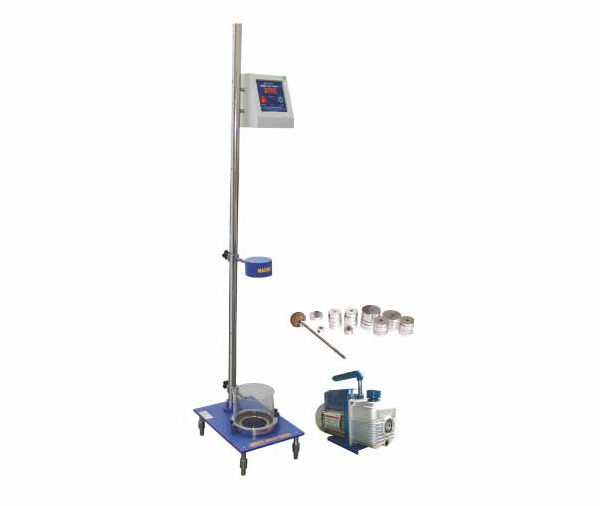Dart Impact testers, also known as Falling Dart Impact testers or simply Dart Impact testers, are laboratory testing machines for assessing the impact resistance and puncture resistance of flexible materials such as films, sheets, laminates, etc. In industries like packaging, plastics, and automotive, it is commonly used to determine a material’s ability to withstand impact forces.
What does a Dart Impact tester consist of?
The Dart Impact tester is fitted with a dart-shaped projectile typically made of steel or tungsten carbide mounted on the pendulum arm and attached to the vertical support structure. After raising it to a certain height, it is released to fall freely and puncture the specimen securely clamped in a specimen holder.
The extent of penetration or energy required for the effect can be used to analyze the material’s impact resistance properties. Generally, measurements such as energy absorbed, the maximum force experienced, and penetration depth are taken into consideration during this test.
How does a Dart Impact tester work
The Dart Impact tester uses kinetic energy from a falling dart to measure the strength of a test specimen. This could be a film, sheet, or other flexible material that has to be firmly positioned into the fixture in line with testing standards. The pendulum arm and steel or tungsten carbide projectile have their own designated weights for accuracy. Once all components are in place, the tests can start.
Before the test is conducted, the Dart Impact tester must be calibrated. This includes checking for accuracy in the pendulum arm’s swing, the dart’s position and any instruments deputed to record force and energy. Afterward, the height at which the dart is dropped is ascertained according to testing specifications. Subsequently, the pendulum arm is raised to that exact level while keeping the dart just above the sample material.
Once the dart is released, it falls under the force of gravity and generates kinetic energy as the pendulum arm swings downward. This energy creates a puncture or hole when it strikes the specimen, leading to deformation and damage. To measure impact force, penetration depth, and other parameters, various sensors and measuring devices integrated into the Dart Impact tester are used. The data collected can then be employed to assess the material’s resistance properties.
To assess a material’s ability to withstand forces and ensure compliance with industry standards, manufacturers and researchers can conduct multiple Dart Impact tests on different locations of the specimen or by using varying dart sizes to obtain representative results. The data acquired here can then be used to inform decisions regarding suitability for specific applications, as well as for quality control and product development purposes.
Applications of Dart Impact Tester
The Dart Impact tester is a widely-used device in various industries for gauging the puncture or impact strength of different materials. Its applications are varied, and this includes the packaging, plastics, and automotive sectors.
In the packaging industry, it is used to evaluate the resilience of films, sheets, and laminates used for making flexible packaging like pouches, wrappers, and plastic bags; finding out their ability to withstand impacts from stacking, dropping, and during transit.
Through Dart Impact testing, the plastics industry can assess the impact properties of thermoplastics as well as thermosets for selecting suitable ones for automotive parts, construction materials, consumer goods, and electronics.
Furthermore, in the automotive sector, it aids in evaluating the resistance to impacts of components such as fenders and bumpers against elements like stone debris or minor collisions.
Besides, film and sheet manufacturing, it helps manufacturers measure the quality and durability of their products. This allows them to ascertain if their films or sheets are capable of withstanding stresses related to their usage, such as protecting packages, agricultural films, or construction membranes.
Moreover, it is also useful in research and development processes for exploring new materials, formulations, and processing techniques. By comparing and optimizing the impact resistance of different materials, Dart Impact testing can help researchers find ways to enhance existing material performance.
Regulatory Compliance
Dart Impact testing can be used to meet industry standards and regulations. For instance, ASTM D1709 and ISO 7765 state the requirements for packaging films, and this testing is an essential part of these criteria. By utilizing this test, industries can verify that their materials and products are up to par quality-wise, increase product longevity, please customers, and minimize the risk of breakage due to impact.
In conclusion,
Dart Impact Testers are an essential tool for assessing the impact resistance of packaging materials. With their precise and reliable testing capabilities, these testers ensure that products are adequately protected during transportation and handling. By simulating real-world scenarios, Dart Impact Testers provide valuable insights into the durability and quality of packaging materials, helping manufacturers make informed decisions and improve their product designs. Investing in Dart Impact Testers not only enhances product safety and customer satisfaction but also reduces potential losses due to damaged goods. With their efficiency and effectiveness, Dart Impact Testers are a vital asset for any packaging industry striving for excellence and ensuring the integrity of their products.
